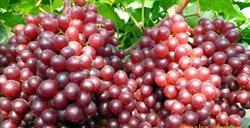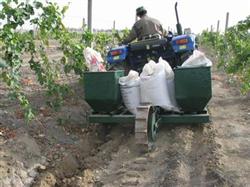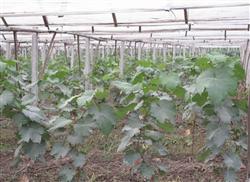Talking about the technology of seedless and early ripening of grape

First, the choice of treatment trees: choose those with normal growth and development and strong tree potential, so that the success rate is high, the fruit setting is good, the seedless rate is high and the fruit is large, and the commodity is good. In the treatment of weak or overgrown trees, the effect is unstable, the fruit is small, and there is a phenomenon of large and small grains. It is necessary to investigate the development of the tree last year to see if there were early defoliation or serious downy mildew, and whether the growth of new shoots stopped too late. If the above phenomenon occurs, it will cause the branch development is not full, such a tree had better not do seedless treatment. 2. Tree management before treatment: 1. Sprouting, binding and heart picking; for those with weak tree potential, flower ears should be identified and sprouts should be wiped as early as possible to make their initial development exuberant. To the apprentice tree, leave 20% of the 30% new shoots, cut off the too strong or too weak branches, so that the power of the branches is balanced, leaving 10-12 strong shoots per square meter. This is very important. Entrapment should be finished before the first treatment, because early entrapment can coordinate the growth and development of new shoots and make the development of flowers consistent. If it can not be tied up before the first treatment, it should be tied in time after treatment, wait for a distance, and be careful not to be closed. Heart picking should be carried out as soon as possible, when the flower ear grows to about 6 leaves (7-10 days before flowering), pick the small tip, and then except for a pair of top shoots, all the lower ones should be made, and the top secondary shoots should be controlled to keep the winter buds unexploded. The number of leaves left in Jufeng grape is 4-5 leaves per 100 grams of fruit. 2. Flower ear management; generally, two ears are left on the strong branches, and one ear is left on the medium and weak branches, which is usually about 20% more than the normal ear amount, because the uncommercial ears after treatment should be removed. It is also necessary to remove the accessory spike, because there is a great difference in the degree of development between the shoulder and the apex in the same spikelet. In order to make the development of the flower bud consistent, the flower spike should be trimmed by removing 3-4 spikelets under the shoulder. Then remove the spike tip (up to 1x6-1x8 of the whole spikelet) and leave about 10 spikelets. The ear weight of picking grains should be 500-600 grams, so large-grain grapes such as Jufeng should leave 35-40 grains per panicle (should be replanted according to a single grain), because once the ear is too large, it is easy to color poorly, so it is very necessary to remove drupes, small nuts and excess grains during panicle trimming, so as to strive for uniform grains with a seedless rate of 100%. Third, the suitable period and method of treatment: generally carry out two treatments (the varieties with obvious seedless tendency can be treated only once), enucleate once before flowering and expand once after anthesis. The second treatment is usually 10-15 days after anthesis, which is easy to master. After the second soaking, it is necessary to trim the ear (remove the over-dense and out-of-harmony with the ear as a whole, make the fruit neat and beautiful, and improve the marketability), bagging (after pruning, the ear is re-sprayed with fungicides, fungicides should be selected, such as Cobo and other pesticides with long effect, and bagging the ear in time after spraying), increase the area of land (seedless cultivation requires strong tree strength and the number of leaves needs to be increased. The new shoot or secondary shoot should be extended after fruit setting, so that the whole new shoot reaches more than 1 meter). The first treatment was due to the great difference of varieties. Varieties with many seeds and difficult to enucleate should be 10 days or earlier before flowering; varieties with seedless tendency can be treated near flowering or early flowering and mixed with too many drupes to reduce the commodity rate. The treatment method has an impact on the treatment effect, generally using ear soaking (10-15 seconds, can not be repeated, do not leak soaking) to deal with more, this method is uniform, less dosage, but the disadvantage is that the spike axis will cause hardening. Spraying or smearing the fruit will increase the dosage, and the drug will not be evenly applied. 4. Agents for seedless treatment: the agents used for seedless treatment are GA (gibberellin), PCPA (p-chlorophenoxyacetic acid), GA+SM, GA+PCPA and LM (already in the "Jufeng" tree, the fruiting rate of the mother branch is high, and the fruiting ability of the auxiliary shoot is strong. In the young tree stage, the short shoot should be pruned mainly, combined with the medium and long shoot pruning, to accelerate the expansion of the fruiting part, and the double branch regeneration method should be adopted. After entering the full fruit period, it is mainly short shoot pruning. Generally, 2-4 nodes are cut, part of the weak branches are recontracted, and 1-2 buds are left at the base. the inflorescences on the new shoots should be removed as soon as possible after sprouting, and the preparatory branches should be cultured to prevent the fruit-bearing parts from moving out and the branch group from aging. The yield per mu should be controlled at about 3000 kg in order to produce high quality fruit. To choose strong branches to keep fruit, the method of leaving one ear with one branch is generally used to ensure that the ear has an adequate supply of nutrients in the growth. The branch-fruit ratio should usually be controlled in the range of 2-3:1. The yield can be properly limited by removing excess inflorescences 2-4 weeks before flowering, removing double spikelets, spikelets and weak spikelets in time, pinching inflorescence tips and accessory spikelets 10 days before flowering. When there are 6-10 new leaves, 3000-5000 times B9 can be sprayed to inhibit the growth of new shoots and promote good results. During the full fruit stage and two weeks after flowering, 15-30ppm and 30-50ppm gibberellin were dipped in flower ear and fruit ear, respectively, and the fruit grain could be increased by 1-2 times. Before sprouting, 5-degree stone-sulfur mixture or 200x dinitrophosphomethyl sodium salt should be sprayed to kill overwintering pathogens. During the fruit growth period, 50% methothalonil 600,800-fold solution, 75% chlorothalonil 600,800-fold solution, 1000-fold solution of 70% methyl topiramate, 65% Dysen zinc 500-fold solution, and 1 Rul 0.5 Vug 200-fold Bordeaux solution should be selected to protect the ear. The main pests are golden wasps, which began to harm early-maturing grapes from the middle of July, eating mature fruits with adults and residual peels, and the control fruits could burn down the wasp nests around the orchards before July. During the fruit ripening period, the tree was used to trap and kill wasps with a trapping solution composed of brown sugar, honey and water (1: 1: 1: 15) and red arsenic. Storage: in the fruit growth period, phosphorus and potassium fertilizer should be applied, in the fruit ripening period, control watering, improve quality, late harvest to improve maturity. With picking, preferred storage, with fruit stalk into storage, the storage environment with sulfur fumigation disinfection, using hanging storage, strictly control the temperature (0-1.5 degrees) humidity about 85%, temperature and humidity distribution is uniform. ", pioneer, rose fragrance, red Fuji, Zaosheng Gaomo, Idou brocade, Jingya, red honey and black whirlwind have been successful, all of which can be used from 3-5 days before flowering to the full flowering stage, and the seedless rate can reach more than 95%. And has the advantages of large fruit, early coloring, not easy to thresh, etc.). Impregnating Jufeng grape inflorescences with GA3 (distributed by Shanghai biochemical Reagent Store) + SM (streptomycin produced by North China Pharmaceutical Co., Ltd.) (50: 100) mg.L-1 5 days before flowering, and then impregnating young ears with GA350mg.L-1 5 days after flowering can make Jufeng grape seedless fruit rate reach 100%, mature 20: 30 days earlier, avoid the market peak, and its unit price is 2 / 3 times higher than that of later listing (control). Fifth, the influence of meteorological conditions on the treatment effect: the meteorological conditions in the first treatment are very important. 8 hours after treatment, more than 20 mm of rainfall needs to be reprocessed, but the treatment concentration needs to be reduced, generally using 50-80% of the original concentration, depending on the rainfall and treatment time. If the weather is unusually dry, 40% relative humidity for a long time will be mixed with drupe, and the fruit and fruit will not expand badly, and the later rain will cause fruit cracking, so it is not suitable to deal with it at abnormal high temperature or noon, and it is better to deal with it in the morning and evening when the humidity is high. And the humidity had better be kept above 80%, so it is necessary to water before and after treatment in arid areas. The temperature of about 20 degrees is the best, above 30 degrees or below 10 degrees will affect the drug absorption. 6. Fertilizer and water management: compared with conventional cultivation, seedless cultivation can shorten 20-25 days from flowering to ripening, and the fruit setting rate is 1-3 times higher than that of conventional cultivation. At the same time, seed reproduction can not produce growth hormone, so large water and fertilizer is needed to meet growth needs. Generally, sprouting fertilizer, pre-anthesis fertilizer, post-anthesis fertilizer, fruit expansion fertilizer, coloring fertilizer and base fertilizer are mainly applied in the first four times. The last two times are mainly phosphorus and potassium fertilizer and soil miscellaneous fertilizer, which should be watered immediately after fertilization. Seventh, pest control: early maturity, generally mature harvest before the rainy season, the disease and insect is very light, only a few times Bordeaux liquid to protect the leaves.
- Prev

Grape Varieties Suitable for Changchun Region
After applying foliar fertilizer skillfully in summer, the following foliar fertilizer can be selected according to the growth of grapes: ① calcium superphosphate leaching solution: 1 kg calcium superphosphate plus 5 kg water, soaked for 12 hours and filtered. When in use, each kilogram of filtered solution can be mixed with 50 kilograms of water to obtain 2% leaching solution.② Plant ash leaching solution: Take 1 kg of plant ash and mix it with...
- Next

High quality and efficient management technology of young grape trees
First, from grape sprouting to late August, topdressing is applied once a month, each time with 5 kg of farm manure and 50 g of nitrogen fertilizer, so as to apply thin fertilizer frequently; second, newly planted grapevines set up small supports to bind new shoots in the same year, and when the new shoots grow to about 20 cm, you can choose to leave one stout shoot and wipe off the rest. ...
Related
- Moge, come on! The staff of the peasant association in the producing area of cantaloupe were frightened when the crowd gathered.
- Causes and Solutions of low Fruit setting rate of Apple
- Symptoms and control measures of passion fruit virus disease
- Fruit growing lesson: how do apple orchards keep high yields?
- Can you build orchards in the mountains? What are the pros and cons?
- How to manage the coloring period of Crisson grape?
- This paper introduces the processing technology of two kinds of fig products.
- How much is a month for retired teachers in rural areas by 2020?
- How can strawberry planting increase sugar content? We should pay attention to management in many aspects.
- What are the cultivation techniques on how to improve the yield of golden fruit?

